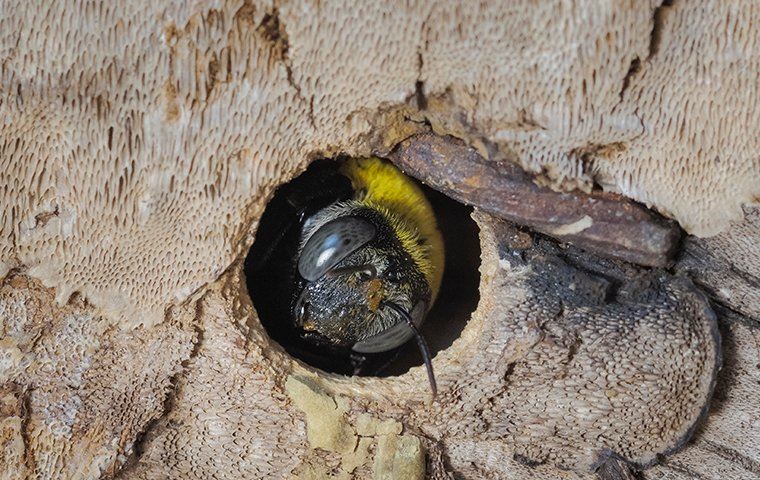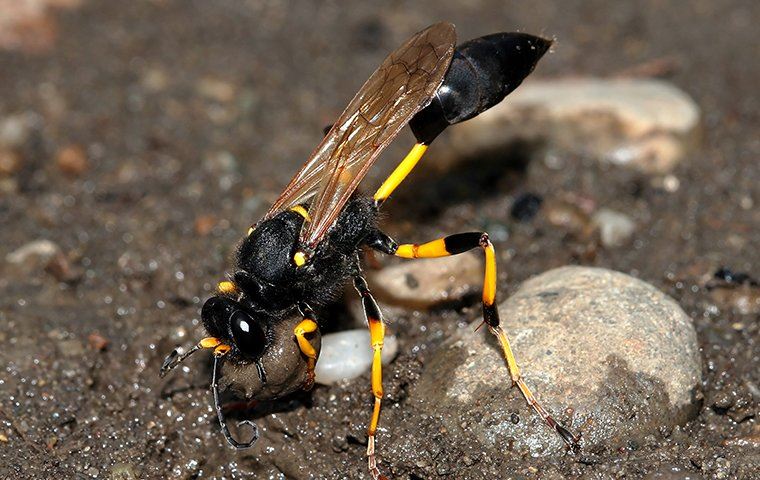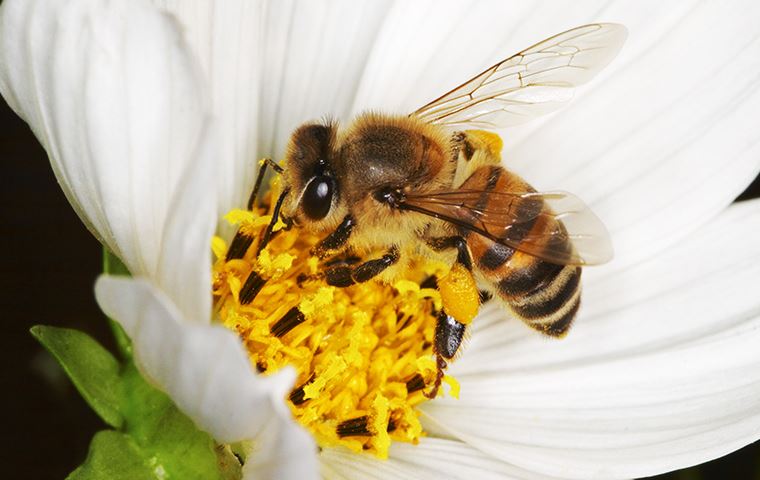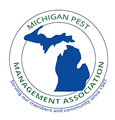
Carpenter Bee Identification & Prevention
.2403141353550.jpg)
Carpenter Bees (Wood Bee)
Carpenter bees, sometimes called Wood Bees or Wood Burrowing Bees, are a common bee found in West Michigan. Carpenter bees are often confused with Bumble Bees. While similar in appearance, there a number of distinguishing features that separate the two bee species. Most notably is the lack of full-body fuzz. Bumble Bees are covered in tiny fuzz all over their bodies, while the Carpenter bee has a yellow, fuzzy front end, and a dark, shiny, hairless abdomen. Males may sometimes have small patches of short hair on their backs and always have a yellow or white face. Carpenter bees are typically ½” to 1” long. They have 6 legs and two sets of wings. They have three body segments that consist of a head, thorax, and abdomen. We specialize in pest control in Muskegon, MI.
Carpenter Bees FAQs
Have questions? We are here to help. Still have questions or can't find the answer you need? Give us a call at 231-300-9558 today!
-
What do carpenter bees do?
Carpenter bees are found all over the United States, especially here in West Michigan. Unlike most bee species, these animals are solitary creatures, however, it’s not uncommon to find a male and female working together.
Carpenter bees do not eat wood for nutrition. Instead, they burrow through the wood to make galleries where the eggs and carpenter bee larvae grow. They eat pollen and nectar from flowering plants and bring it back to the nest for the carpenter bee larvae to feed on. While they do provide pollination for plants, they aren’t “heavy-lifters” like other bee species such as the Honey Bee or Bumble Bee.

-
Where do carpenter bees build their nests?
Carpenter bees build their nests in softwood, earning them the nick-name Wood Bees or Wood Burrowing Bees. Old, untreated, and unpainted wood around your home makes perfect nests for carpenter bees. You’ll often find them burrowed in porches, old trees, sheds or any other structure with softwood. Coniferous trees are a favorite home for them. They’ll burrow round holes about ½ inch in diameter and can leave “frass” or sawdust outside the entrance.
Most carpenter bee nests will consist of a male and a female. The male bee stands guard, hovering around the nest to protect it from predators. Most often if you are attacked by a carpenter bee it will be the male. The female is the only bee that actually burrows in wood. She can burrow 2-4 feet through wood every season as she makes her nesting gallery for her carpenter bee larvae to grow.
-
How much damage can carpenter bees cause?
Like termites, Carpenter Bees are one of the primary wood-destroying insects in the United States. Unlike termites, Carpenter Bees don’t actually eat the wood. They prefer softwoods like conifers. Always the opportunist, carpenter bees are just as likely to find a home in your home or other outside structure. The female will burrow a hole a ½ inch wide about 4 – 6 inches deep. Once inside she will begin to branch off into multiple chambers perpendicular to the main tunnel. These tunnels are often inhabited by multiple generations and can grow up to 4 feet each season!
While rare, given enough time, carpenter bees can cause serious structural damage to any structure. They have also been known to kill trees if gone unchecked. And the bees themselves are not the only problem. Woodpeckers can wreak havoc on the structure while they peck at your structures or trees trying to get at the bees. In fact, a single woodpecker will cause significantly more damage than the bees ever could. By removing the bees you are also deterring woodpeckers from looking for food within your home or structure.
-
Can carpenter bees sting?
The male Carpenter Bee is EXTREMELY territorial. They spend their day hovering around the nest. They’ll dive-bomb any insect, animal or human that wanders too close. This can be very intimidating due to their large size. The male Carpenter Bee will make a very loud buzzing sound and bump into you with its large body. But this is all an empty threat. Male Carpenter Bees don’t actually have a stinger so they are unable to hurt you.
Only the female carpenter bee has a stinger. Fortunately, it’s very unlikely you’ll ever be accidentally stung by one. Female carpenter bees are generally docile but will defend herself if necessary. But she’s not easily threatened. If you’re waving your hands around trying to swat at her, or are digging into her nest, you’ll very likely get stung. If you stay calm and leave her alone, she’ll do the same.
-
Are carpenter bees dangerous?
Despite the aggressive nature of the male Carpenter Bee, he can’t hurt you in any way since he doesn’t have a stinger. The female, however, can and will attack if threatened. The carpenter bee sting is very similar to a bumblebee sting, but since they are solitary creatures, you’ll never be swarmed by a nest of carpenter bees. The female is capable of stinging multiple times. Each sting injects venom containing Melittin, a component that causes pain and the destruction of tissue.
A typical reaction to a Carpenter Bee sting is an immediate sharp pain for a few minutes, followed by dull aching. The bee sting often causes redness and swelling in the immediate area around the sting. The redness and swelling will reduce in time. The skin may continue to be sensitive and itch over the next few days.
Carpenter Bees are not usually dangerous to humans. However, people allergic to bee venom may experience a severe allergic reaction to the sting. If stung, they can experience any number of the following symptoms, and should seek immediate medical attention! Extreme allergic reactions can be fatal!
- Significant skin reactions like hives, itching, and flush or pale skin
- Difficulty breathing
- Swelling of the throat or tongue
- A weak, rapid pulse
- Nausea, vomiting or diarrhea
- Dizziness or fainting
- Loss of consciousness
-
How can I get rid of carpenter bees?
There are a number of ways you can get rid of nuisance Carpenter bees on your property. Due to the potentially dangerous nature of bee stings, we strongly recommend hiring a professional exterminator to inspect and remove any nests.
Safeguard Pest Solutions is your best choice for quality, local bee removal services. We specialize in beehive removal and will advise you on how to prevent future infestations. We offer quality home pest control and commercial pest control solutions and reasonable rates. Call or contact us today for a free consultation.

Why Choose Safeguard Pest Solutions?
-
Safe SolutionsYou shouldn’t have to worry that your pest control is more dangerous than the pests in your home. Safeguard Pest Solutions uses natural solutions to safeguard your home from all unwanted pests.
-
Quality ServicesAs a family-owned-and-operated West Michigan pest control company, Safeguard Pest Solutions provides safe, high-quality pest control services administered by licensed and certified service professionals.
-
Satisfaction GuaranteedAt Safeguard Pest Solutions, your satisfaction is important to us. We customize our safe treatments to tackle your pest problems, and our effective pest control guarantees your complete satisfaction.

Other Resources
-
 Mud DauberMud Daubers, or Mud Wasps, is a name commonly used to describe wasps that build their nests from mud. The Mud Dauber has 6 legs. It is long and slender with a thing, thread-like, waist. Most resemble long slender wasps about .5 to 1 inch (25mm) in length.
Mud DauberMud Daubers, or Mud Wasps, is a name commonly used to describe wasps that build their nests from mud. The Mud Dauber has 6 legs. It is long and slender with a thing, thread-like, waist. Most resemble long slender wasps about .5 to 1 inch (25mm) in length. -
 Sting TreatmentWash the sting area with soap and water. This not only removes any dirt but will also disinfect the area preparing it for possible further first aid. The area around the sting will turn red. It will possibly burn a little bit and swell up.
Sting TreatmentWash the sting area with soap and water. This not only removes any dirt but will also disinfect the area preparing it for possible further first aid. The area around the sting will turn red. It will possibly burn a little bit and swell up. -
 Honey BeesGiven the off chance that you have undesirable honey bees around your home, you can contact a neighborhood beekeeper who might have the option to eliminate the honey bees without killing them.
Honey BeesGiven the off chance that you have undesirable honey bees around your home, you can contact a neighborhood beekeeper who might have the option to eliminate the honey bees without killing them.

Happy Customers in Your Neighborhood
Proudly Serving West Michigan & the Surrounding Areas
Check out some of our recent reviews!
-
“Very good price compared to others. Jeff came sprayed where my bees were and they were all dead the next day. Excellent service!”- Shana Phelps
-
-
“Safeguard Pest Solutions of Muskegon MI is one of the best, customer friendly, fast response time businesses I have ever experienced. I called in the morning and Jeff was at my house that afternoon! He knew exactly how to handle my situation and immediatel”- Nan Johnson
-
“Always provides such good service! We’ve used for years and will continue to! Such good pest prevention!”- Emma Hichue
Safeguard Pest Solutions Blog
Want all the latest news or updates? Browse through our blog to read our most recent posts and featured articles.

.2403141327550.jpg)





